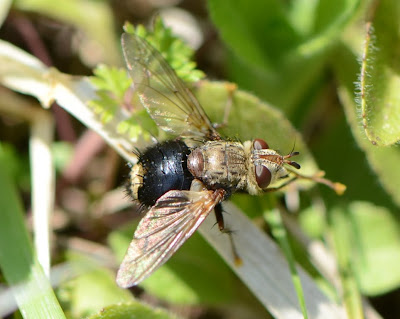I spent all of yesterday plumbing the depths of southern Ohio's Shawnee State Forest, unfettered by schedules, people, or things. Well, one thing - my new Nikon D-7000. This was the first day that I've had to really fool around with this camera and its 105 mm macro lens. I am but an inexperienced piker with this setup, but the camera with that lens is amazing! I hope to progressively get better with it, and start to learn more about using flash and other tricks.
Anyway, Shawnee was great as always and I saw scads of interesting stuff. I did spend a lot of time looking at and photographing insect pollinators, mostly the often colorful flower flies that so ably mimic bad guys such as wasps and bees. More on those in a later post, if I get to them, but for now it's a beetle. And what a beetle!

Early-blooming wildflowers, such as this pussy-toes,
Antennaria plantaginifolia, which sometimes goes by the odd name of "woman's tobacco", are very important nectar sources for vernal insects. Pussy-toes, which in this species typically form sizeable colonies, are good for finding lots of interesting bugs. Those are bluets,
Houstonia caerulea, in the backdrop - another good nectar source.

I was after some fly shots when I noticed this little beauty wing in and plunk down on some pussy-toes flowers. It's small - perhaps one-half inch in length and I don't think I would have noticed what an exquisite animal it was had I not been turning my macro lens to small bugs.
Anyway, it is the so-called "bronze blister beetle, Lytta aenea. Having the word "blister" in your title does not sound flattering and indeed the beetle does have some caustic chemicals within its hard-shelled exoskeleton. But who cares - look at this thing! It would be hard for a metal-working artisan to create such a thing. Everything about this beetle is cool, from those ornately braided antennea to the head and thorax which look as if they've been plated in high quality bronze. The iridescent purplish wings contrast nicely with the yellow legs.
A major piece of work on a minor scale, this one.

Blister beetles, which can often be found visiting flowers for nectar, get their name from the presence of
cantharadin, a nasty chemical they carry. Accidentally ingest one of these things and you'll regret it. There's a whole raft of bad effects, including greatly elevated temperature, rapid heart rate, diarrhea and dehydration. Depression is another cited effect, perhaps because all of those other bad things are happening to you.
Even getting cantharadin on your skin can cause nasty blisters and inflammation, so it's better to admire blister beetles from afar.
 The verdant landscapes of spring, along a rural Adams County roadside. But wait! What's that mist of white flowers creating a drift along the verge?
The verdant landscapes of spring, along a rural Adams County roadside. But wait! What's that mist of white flowers creating a drift along the verge? This one is worth stopping for. It's False Garlic, Nothoscordum bivalve, an Ohio threatened plant. While it acts rather weedy, False Garlic occurs only in a limited area of southernmost Ohio, primarily in Adams County. Start moving south, and the plant becomes abundant. I once drove to Texas at this time of year, and False Garlic became a prolific roadside - dare I say - "weed" in many areas.
This one is worth stopping for. It's False Garlic, Nothoscordum bivalve, an Ohio threatened plant. While it acts rather weedy, False Garlic occurs only in a limited area of southernmost Ohio, primarily in Adams County. Start moving south, and the plant becomes abundant. I once drove to Texas at this time of year, and False Garlic became a prolific roadside - dare I say - "weed" in many areas. Up close and personal, we can clearly see that this species is in the lily family (Liliaceae) with its six-parted flowers. False Garlic greatly resembles some of the wild onions in the genus Allium, but with the possible exception of Nodding Wild Onion, A. cernuum, those species do not have nearly as showy flowers. Also, had I plunked down in a patch of true onions to make some photos, as I did here, the powerful, pungent aroma of onions would have risen to greet me. False Garlic is inodorous - it produces no smell.
Up close and personal, we can clearly see that this species is in the lily family (Liliaceae) with its six-parted flowers. False Garlic greatly resembles some of the wild onions in the genus Allium, but with the possible exception of Nodding Wild Onion, A. cernuum, those species do not have nearly as showy flowers. Also, had I plunked down in a patch of true onions to make some photos, as I did here, the powerful, pungent aroma of onions would have risen to greet me. False Garlic is inodorous - it produces no smell.
















































